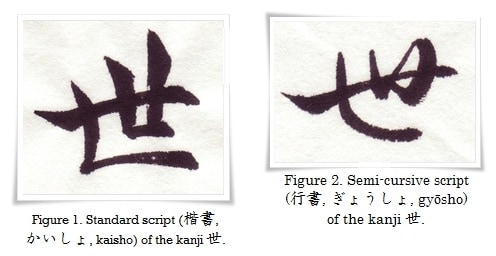The modern form of せ comes from the cursive form of the kanji 世 (せ, se, i.e. “world”, “society”), though it would seem that semi-cursive style is visually closer to the shape of せ. Due to a fact that kanji 世 has multiple forms in standard script (楷書, かいしょ, kaisho), its cursive script forms may vary quite significantly from one another. Follow the progression of the different scripts shown in Figures 1 to 3 to understand the origin of せ.
Figure 1. Standard script (楷書, かいしょ, kaisho) of the kanji 世.
Figure 2. Semi-cursive script (行書, ぎょうしょ, gyōsho) of the kanji 世.
Figure 3. Cursive script (草書, そうしょ, sōsho) of the kanji 世.
Figure 4. Calligraphy of the hiragana character せ. Note the corresponding shape with the semi-cursive and cursive forms of the character 世.
Figure 5. The word せい (sei, i.e. “nature”) written in Japanese kana (かな) script. The hiragana character い is based on the cursive form of the kanji 以 (い, i, i.e. “by means of”, “because of”, etc.), which is explained in this article.



